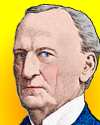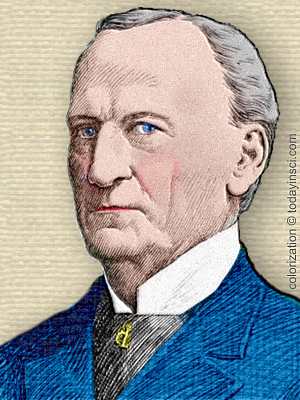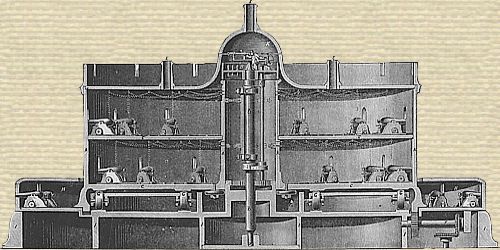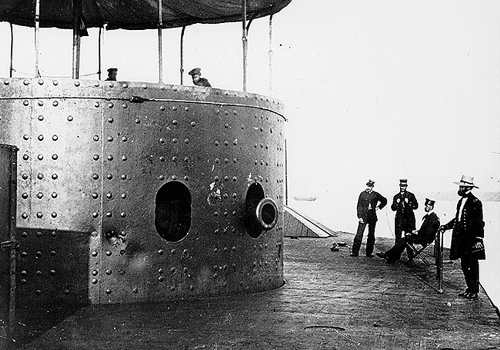 (source)
(source)
|
Theodore Ruggles Timby
(5 Apr 1819 - 9 Nov 1909)
American inventor who first had the idea for the revolving turret that John Ericcson built on the ship Monitor which proved to be a decisive advance in naval armaments during its successful encounter with the ironside Merrimac (9 Mar 1862).
|
Theodore R. Timby
from People’s Book of Biography (1873)
by James Parton
———o•o———
[p.233] IT is safe to say that not one in ten of the American people ever heard of the gentleman whose name stands at the head of this article. Still more certain is it that every American citizen is indebted to him for a service of the greatest importance.
It was remarkable, during the late war, that the news of the most thrilling events usually reached New York on Sunday. Who will ever forget that Sunday evening, in March, 1862, when an “Extra” horrified us all with the intelligence that the long-derided iron-clad monster, Merrimac, had “come out” at last, and sunk the Congress, captured and burnt the Cumberland, driven the Minnesota aground, thrown shot into the camp at Newport News, and only awaited the dawn of another day to continue her ravages: We were informed, too, that the heaviest cannon-balls glanced from her iron armor as harmlessly as hailstones from a slate-covered roof. What was to prevent this new engine of war from raining destruction upon Fortress Monroe and upon General McClellan’s army? Nay, what had we that could prevent her steaming up the Potomac, and destroying the city of Washington?
This was bad news to go to bed upon; but we were hardened to bad news then, and most of us, I suppose, slept our regular allowance. But oh, the relief, when we seized the paper next morning, and read the strange tale of the Monitor’s interposition; how a “small raft with a cheese-box upon it” had come between the Merrimac and her helpless prey, the grounded Minnesota, and, after a four hours’ fight, driven the monster off disabled!
If, on that day, I could have gone down town and pointed out to the crowd in Wall Street the man in whose brain the idea [p.234] of the Monitor originated, good heavens! what would they have done with him? Or, still better, if I could have taken him on board the rescued Minnesota, would it not have required all the spell of discipline to prevent the sailors from hugging him to within an inch of his life?
I have the honor of presenting this gentleman to the reader: Theodore R. Timby is his name. He is a native of Dutchess County, in the State of New York, and now resides at Saratoga Springs, in the same State. His claim to the invention has been acknowledged by the government, and he has received, as owner of the patent, a certain sum upon every turreted vessel built since the Monitor demonstrated their utility. Strange to relate, this invention was twenty years old when the war broke out, and Mr. Timby’s first patent had slumbered, useless and scarcely known, for a period of eighteen years. This arrow remained in the national quiver all that time, to be drawn forth at a critical moment, and used with an effect that astonished all the world.
Theodore R. Timby, born in 1822, a farmer’s son, educated in the public schools of his native State, was an inventor almost from his childhood. At the age of sixteen he made one of the most brilliant inventions of our age, — that of the floating dry-dock. Readers in the country, perhaps, do not know what a floating dry-dock is. It is a huge wooden box, sunk to the bottom of the river by being filled with water. When it is desired to raise a ship out of water, for the purpose of repairing or coppering her bottom, she is floated over and fastened to this sunken box. The water is then pumped out of the box by steam pumps, which, of course, causes it to rise to the surface, carrying the ship up with it. By this simple contrivance I once saw a Cunard steamship, with all her freight and coal on board, lifted out of the water in about two hours. This exquisite invention was made by a boy of sixteen. Many persons still living saw his model and admired his idea; but he was too young to pursue it, and his dock was subsequently re-invented, patented, and brought into general use by other parties.
His notion of a revolving turret was also a fancy of his boyhood. He has still in his possession a model of a revolving [p.235] tower, cut in ivory when he was nineteen years old. He designed his tower for use both on land and sea, and his first patent, dated January 18, 1843, specifies this twofold use. On shore, his invention would be a revolving, iron-clad fort; employed on the sea, it is a revolving, iron-clad, floating battery.
In the spring of 1843, having obtained his patent, the young inventor proceeded to construct a model of a revolving fortress, twenty-one feet in circumference. This model was made at Syracuse, and was afterwards brought to New York, where it was publicly exhibited, and described in the newspapers. When President Tyler passed through New York, in June of that year, it was shown to him in the Governor’s Room of the City Hall. The invention was admired by all competent persons who inspected it; but no one, it appears, appreciated its importance. No iron-clad vessels having yet been built, and rifled cannon being unknown, the necessity of iron-clad forts was not apparent. The inventor was told, by the military authorities at Washington, that the forts already existing were sufficient for the defence of our harbors, and his invention was totally neglected by them.
As on a lovely day in summer it is difficult to realize that, ere many months have passed, the earth will be covered with snow, and wintry winds howling through the leafless trees, so, when peace has long blessed a country, it is not easy to believe that war will one day threaten and desolate its shores. I well remember walking over Governor’s Island, in New York harbor, some years ago, and finding its principal fortification without a serviceable gun, and tenanted only by one woman. For many years before the outbreak of the late war, another island in the harbor, filled with warlike stores, was in the custody of one sergeant. In 1843 Mr. Timby could get no official person to urge the adoption of his invention, which he had expended several thousand dollars in completing. In 1848 he made such progress as to get a committee appointed to examine his plans and models. One member of this committee was Jefferson Davis. These gentlemen joined the Chef of Ordnance in reporting favorably upon the invention to Mr. Marcy, the Secretary of War; and there the matter rested. It would have [p.236] required, indeed, a very bold and far-seeing Secretary of War to have undertaken, in 1848, the erection of revolving iron-clad forts and floating batteries.
Mr. Timby then went to France, and submitted his plans to the government of Louis Napoleon. He had no better success at Paris than at Washington.
Never did he cease to meditate and improve upon his original conception, although compelled to direct his chief attention to other business. He made several valuable inventions, twenty of which were patented. When the war broke out, in 1861, he felt that the time had come to bring his favorite scheme to bear upon the defence of his country, and he immediately made a new model of his revolving tower, which combined all the improvements which eighteen years of reflection had suggested. This model he took to Washington, and placed it in a room of the Treasury Department, where it was seen by the members of the cabinet and the public. The value of the idea was not yet fully recognized. It was not until the immortal Monitor had done her glorious morning’s work in Hampton Roads, a year later, that Mr. Timby’s invention was hailed throughout the world as a most important addition to the art of war.
It is pleasant to record that the inventor of the iron-clad revolving turret, after waiting twenty-two years for his reward, obtained it at last, and without difficulty. His claim to the invention was not disputed, and could not be. A new patent was issued to him, covering all his late improvements. The gentlemen who had contracted to build Monitors for the government offered terms to the inventor, which he considered just, and which he accepted. His emoluments, of course, have not been as great as those of some enterprising sutleres, who sold whiskey and water to the troops at five dollars a bottle, but they have been such as satisfy a man of moderate desires and intellectual tastes.
The turret principle has not yet been applied to the construction of forts, and I know not whether such an application of it is in contemplation. One thing may be regarded as certain: no fort made of masonry can resist the ordnance now employed in the navies of Great Britain, France, and the United States.
[p.237] I believe that both France and England possess vessels that could run by the forts defending New York, Boston, Philadelphia, Baltimore, and Charleston, and anchor off either of those cities, holding them at their mercy. The only safeguard our cities have is the fleet of turreted iron-clads, which originated in the ingenious brain of Theodore R. Timby. Whether these are sufficient, without the aid of iron-clad forts on land, is a question, the solution of which ought not to be deferred until we are again involved in war.
- Theodore Timby - recognition as inventor from Successful American (1902).







